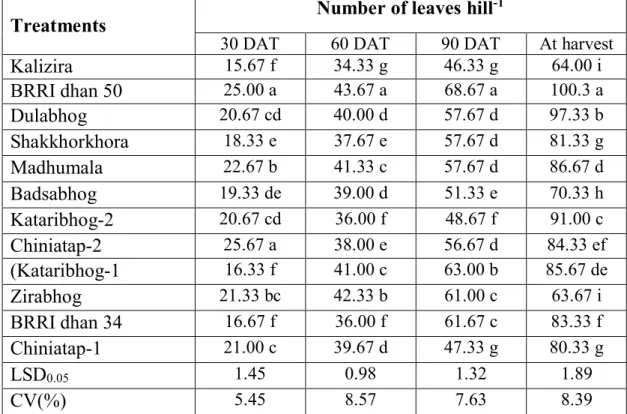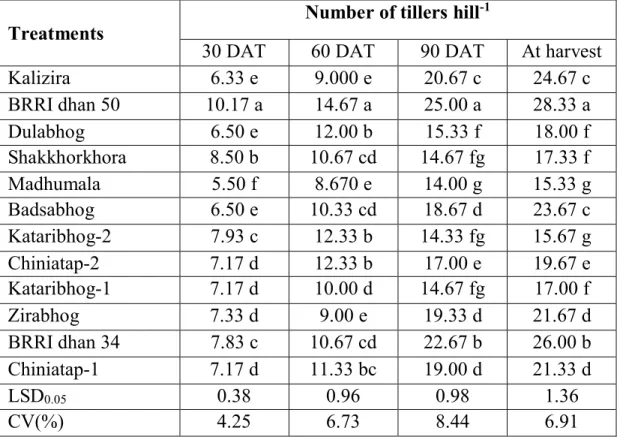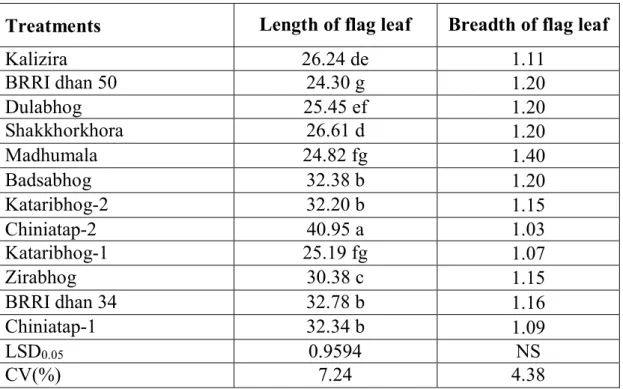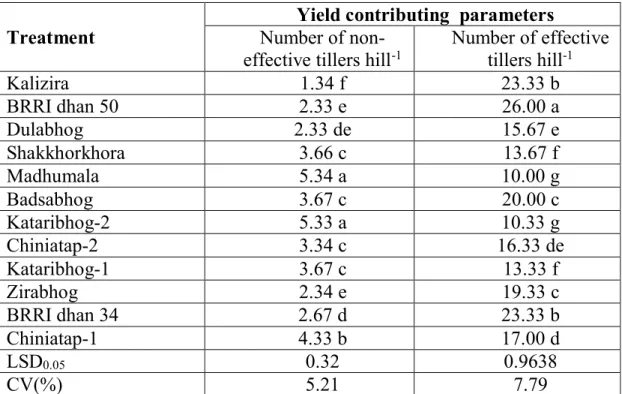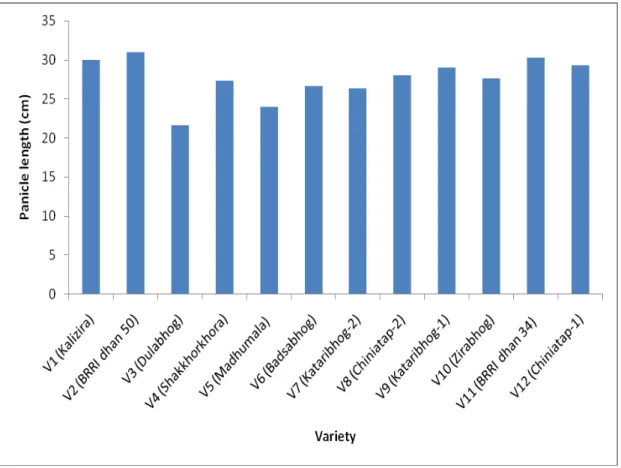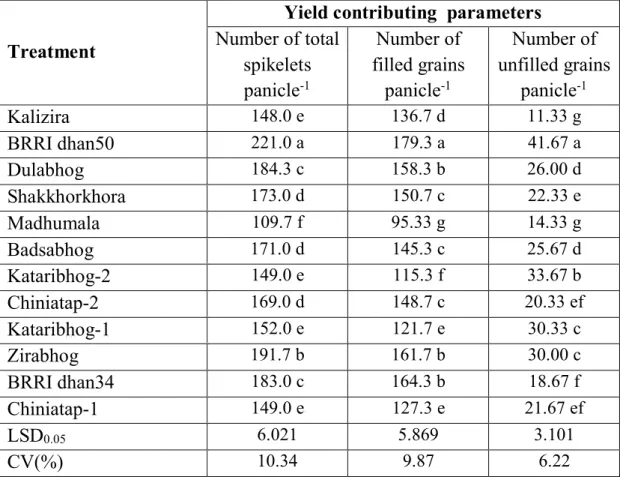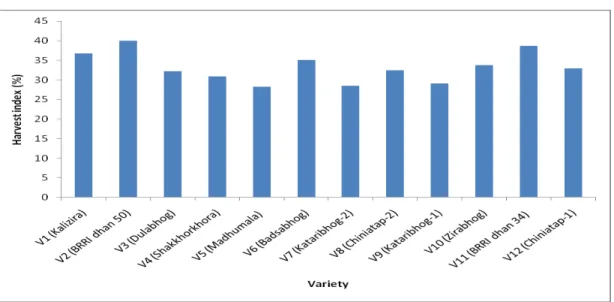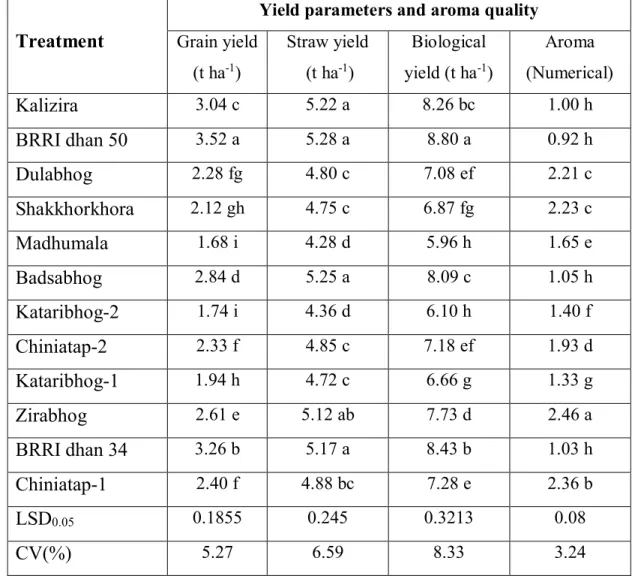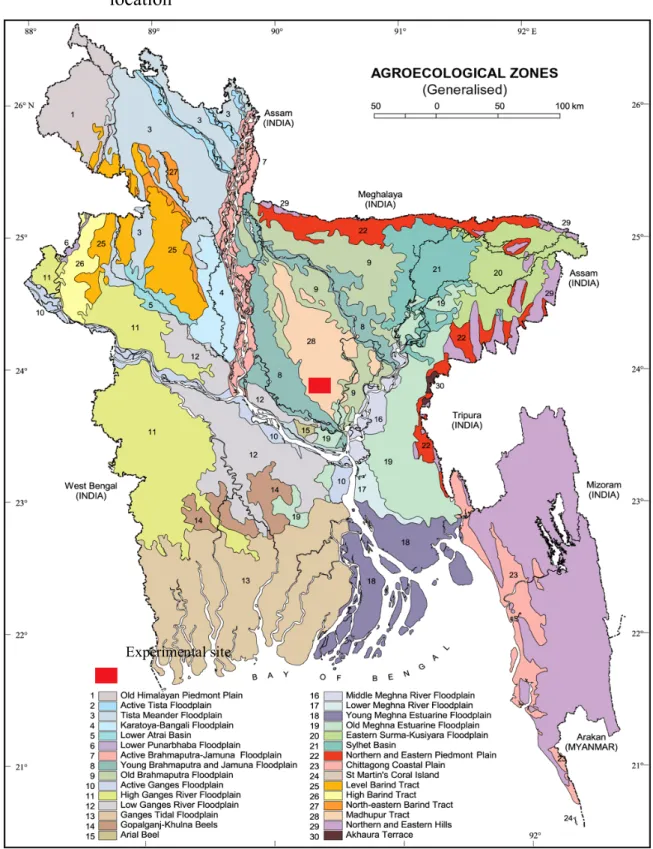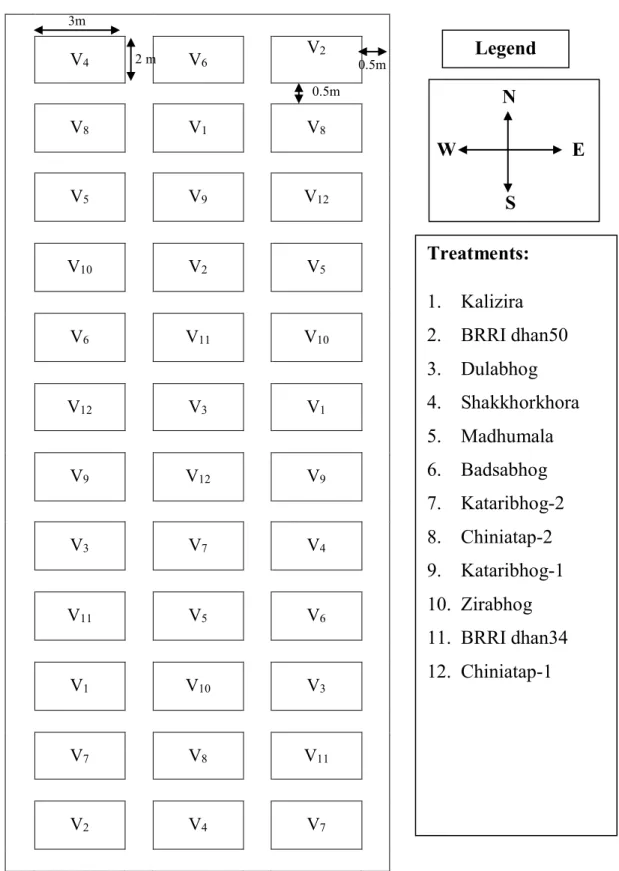i
ADAPTABILITY ASSESSMENT OF TRADITIONAL AROMATIC RICE CULTIVARS IN BORO SEASON BASED ON GROWTH
VARIABLES, AROMA QUALITY AND YIELD
SATU BISWAS
DEPARTMENT OF AGRICULTURAL BOTANY SHER-E-BANGLA AGRICULTURAL UNIVERSITY
DHAKA -1207
JUNE, 2020
ii
ADAPTABILITY ASSESSMENT OF TRADITIONAL AROMATIC RICE CULTIVARS IN BORO SEASON BASED ON GROWTH
VARIABLES, AROMA QUALITY AND YIELD BY
SATU BISWAS
REGISTRATION NO. : 13-05325 A Thesis
Submitted to the Department of Agricultural Botany Sher-e-Bangla Agricultural University, Dhaka
In partial fulfillment of the requirements for the degree of
MASTER OF SCIENCE (MS) IN
AGRICULTURAL BOTANY SEMESTER: JANUARY- JUNE, 2020
Approved by:
Md. Tofail Hosain Assistant Professor
Department of Agricultural Botany SAU, Dhaka
(Supervisor)
Dr. Md. Moinul Haque Professor
Department of Agricultural Botany SAU, Dhaka
(Co-Supervisor)
Dr. Kamrun Nahar Chairman
Department of Agricultural Botany
iii
DEPARTMENT OF AGRICULTURAL BOTANY Sher-e-Bangla Agricultural University
Sher-e-Bangla Nagar,Dhaka-1207
CERTIFICATE
This is to certify that the thesis entitled
“ADAPTABILITY ASSESSMENT OF TRADITIONAL AROMATIC RICE CULTIVARS IN BORO SEASON BASED ON GROWTH VARIABLES, AROMA QUALITY AND YIELD”
submitted to the Department of Agricultural Botany, Faculty of Agriculture, Sher-e- Bangla Agricultural University, Dhaka, in partial fulfillment of the requirements for the degree ofMASTERS OF SCIENCE (M.S.)
inAgricultural Botany, embodies the result of a piece of bonafide research work carried out by
Satu Biswas
, RegistrationNo.13-05325
under my supervision and guidance. No part of the thesis has been submitted for any other degree or diploma.I further certify that any help or source of information, received during the course of this investigation has been duly acknowledged.
June, 2020
Dhaka, Bangladesh
Md. Tofail Hosain Assistant Professor
Department of Agricultural Botany SAU, Dhaka
iv
Dedicated to My
Beloved Parents
i
ACKNOWLEDGEMENTS
The author seems it a much privilege to express his enormous sense of gratitude to the almighty God for there ever ending blessings for the successful completion of the research work.
The author wishes to express his gratitude and best regards to his respected Supervisor, Md. Tofail Hosain, Assistant Professor, Department of Agricultural Botany, Sher-e-Bangla Agricultural University, Dhaka, for his continuous direction, constructive criticism, encouragement and valuable suggestions in carrying out the research work and preparation of this thesis.
The author wishes to express his earnest respect, sincere appreciation and enormous indebtedness to his reverend Co-supervisor, Dr. Md. Moinul Haque, Professor, Department of Agricultural Botany, Sher-e-Bangla Agricultural University, Dhaka, for his scholastic supervision, helpful commentary and unvarying inspiration throughout the research work and preparation of the thesis.
The author feels to express his heartfelt thanks to the honorable Chairman, Dr.
Kamrun Nahar,Associate Professor, Department of Agricultural Botany along with all other teachers and staff members of the Department of Agricultural Botany, Sher- e-Bangla Agricultural University, Dhaka, for their co-operation during the period of the study.
The author feels proud to express his deepest and endless gratitude to all of his course mates and friends to cooperate and help him during taking data from the field and preparation of the thesis. The author wishes to extend his special thanks to his lab mates, class mates and friends for their keen help as well as heartiest co-operation and encouragement.
The author expresses his heartfelt thanks to his beloved parents, Elder Sister and Brother and all other family members for their prayers, encouragement, constant inspiration and moral support for his higher study. May Almighty bless and protect them all.
The Author
ii
ADAPTABILITY ASSESSMENT OF TRADITIONAL AROMATIC RICE CULTIVARS IN BORO SEASON BASED ON GROWTH
VARIABLES, AROMA QUALITY AND YIELD Satu Biswas
ABSTRACT
The experiment was conducted at the experiment field of Sher-e-Bangla Agricultural University (SAU), Dhaka during the period from December 2018 to May 2019 to study the adaptability assessment of traditional aromatic rice cultivars in Boro season based on growth variables, aroma quality and yield. The experiment comprised of single factor (variety). Twelve aromatic rice varieties viz., Kalizira, BRRI dhan 50, Dulabhog, Shakkhorkhora, Madhumala, Badsabhog, Kataribhog-2, Chiniatap-2, Kataribhog-1, Zirabhog, BRRI dhan 34 and Chiniatap-1 were considered for the present study. The experiment was laid out in a Randomized Complete Block Design (RCBD) with three replications. Data on different growth, yield contributing parameters, yield parameters and quality parameters were recorded and analyzed statistically. The highest number of effective tillers hill-1 (26.00), length of panicle (31.00 cm), number of total grains panicle-1 (221.00), number of filled grains panicle-1 (179.30), grain yield (3.52 t ha-1), straw yield (5.28 t ha-1), biological yield (8.80 tha-1) and harvest index (40.00%) were found from BRRI dhan 50 whereas the lowest grain yield (1.68 t ha-1), straw yield (4.28 t ha-1), biological yield (5.96 t ha-1) and harvest index (28.1900%) were recorded from Madhumala. In case of aroma quality, variety Zirabhog showed strong aroma whereas the mild aroma was found from BRRI dhan50. So, considering overall performance, BRRI dhan50 gave best performance, and this variety may be considered as best among the varieties under the present study.
iii
LIST OF CONTENTS
Chapter Title Page
No.
ACKNOWLEDGEMENTS i
ABSTRACT ii
LIST OF CONTENTS iii
LIST OF TABLES v
LIST OF FIGURES vi
LIST OF APPENDICES vii
ABBREVIATIONS AND ACRONYMS viii
I INTRODUCTION 1-3
II REVIEW OF LITERATURE 4-19
III MATERIALS AND METHODS 20-27
3.1 Site description 20
3.2 Climate 20
3.3 Soil 20
3.4 Treatments 21
3.5 Plant materials and collection of seeds 21
3.6 Seed sprouting 21
3.7 Preparation of nursery bed and seed sowing 22
3.8 Preparation of experimental land 22
3.9 Fertilizer application 22
3.10 Experimental design and layout 23
3.11 Uprooting of seedlings 23
3.12 Transplanting of seedlings in the field 23
3.13 Intercultural operations 23
3.14 Harvesting, threshing and cleaning 24 3.15 General observation of the experimental field 24
3.16 Recording of data 24
3.17 Procedures of recording data 25
3.18 Statistical analysis 28
IV RESULTS AND DISCUSSION 29-40
4.1 Growth parameters 29
4.1.1 Plant height 29
iv
LIST OF CONTENTS (Cont’d)
Chapter Title Page
No.
IV RESULTS AND DISCUSSION 29-40
4.1.2 Number of leaves hill-1 30
4.1.3 Number of tillers hill-1 31
4.1.4 Length of flag leaf 32
4.1.5 Breadth of flag leaf 32
4.2 Yield contributing parameters 33
4.2.1 Number of non-effective tillers hill-1 33 4.2.2 Number of effective tillers hill-1 34
4.2.3 Length of panicle 35
4.2.4 Number of total grains panicle-1 35
4.2.5 Number of filled grains panicle-1 36
4.2.6 Number of unfilled grains panicle-1 36
4.3 Yield parameters and aroma quality 37
4.3.1 Weight of 1000 grains 37
4.3.2 Grain yield 38
4.3.3 Straw yield 39
4.3.4 Biological yield 39
4.3.5 Harvest index 39
4.3.6 Aroma quality 40
V SUMMARY AND CONCLUSION 41-43
REFERENCES 44-50
APPENDICES 51-55
v
LIST OF TABLES
Table
No. Title Page
No.
1. Number of leaves hill-1 of rice at different days after transplanting as influenced by different cultivars
31
2. Number of tillers hill-1 of rice at different days after transplanting as influenced by different cultivars
32
3. Length and breadth of flag leaf of rice as influenced by different cultivars
33
4. Effective and non-effective tillers hill-1 of rice as influenced by different cultivars
34 5. Yield contributing parameters of rice as influenced by
different cultivars
37 6. Yield parameters and aroma quality of rice as influenced by
different cultivars
40
vi
LIST OF FIGURES
Figure
No. Title Page
No.
1. Plant height of rice at different days after transplanting as influenced by different cultivars
30
2. Panicle length of rice as influenced by different cultivars 35 3. Thousand seeds weight of rice as influenced by different
cultivars
38
4. Harvest index of rice as influenced by different cultivars 39
5. Experimental site 51
6. Layout of the experimental plot 53
vii
LIST OF APPENDICES
Appendix
No. Title Page
No.
I. Agro-Ecological Zone of Bangladesh showing the experimental location
51 II. Monthly records of air temperature, relative humidity and
rainfall during the period from December 2018 to May 2019
52 III. Characteristics of experimental soil analyzed at Soil Resources
Development Institute (SRDI), Farmgate, Dhaka
52
IV. Layout of the experiment field 53
V. Plant height of rice at different days after transplanting as influenced by different cultivars
54 VI. Number of leaves hill-1 of rice at different days after
transplanting as influenced by different cultivars
54 VII. Number of tillers hill-1 of rice at different days after
transplanting as influenced by different cultivars
54 VIII. Length and breadth of flag leaf of rice as influenced by different
cultivars
54 IX. Effective and non-effective tillers hill-1 of rice as influenced by
different cultivars
55 X. Yield contributing parameters of rice as influenced by different
cultivars
55 XI. Yield parameters and aroma quality of rice as influenced by
different cultivars
55
viii
ABBREVIATIONS AND ACRONYMS
AEZ = Agro-Ecological Zone
BBS = Bangladesh Bureau of Statistics
BCSRI = Bangladesh Council of Scientific Research Institute cm = Centimeter
CV = Coefficient of Variation DAS = Days After Sowing
DMRT = Duncan’s Multiple Range Test et al., = And others
e.g. = exempli gratia (L), for example etc. = Etcetera
FAO = Food and Agricultural Organization g = Gram (s)
i.e. = id est (L), that is Kg = Kilogram (s)
LSD = Least Significant Difference m2 = Meter squares
ml = Mililitre
M.S. = Master of Science No. = Number
SAU = Sher-e-Bangla Agricultural University var. = Variety
oC = Degree Celsius
% = Percentage
NaOH = Sodium hydroxide GM = Geometric mean mg = Milligram
P = Phosphorus
K = Potassium
Ca = Calcium
L = Litre
μg = Microgram
USA = United States of America WHO = World Health Organization
1 CHAPTER I INTRODUCTION
Rice (Oryza sativa L.) is the most important food crop in Bangladesh and also it is the staple food of more than half of the world’s population. Among the leading rice growing countries of the world, Bangladesh is ranked 3rd in both rice area and production (BRRI, 2019). Rice is the major staple food crop in Bangladesh, covering about 75% of the total cropped area. Ninety percent global rice production occurs in tropical and sub-tropical Asian countries (Ashraf et al., 2017). Worldwide, rice provides 27% of dietary energy supply and 20% dietary protein (Sangeetha et al., 2013). It constitutes 95% of the cereal consumed and supplies more than 80% of the calories and about 50% of the protein in the diet of the general people of Bangladesh (Sumon et al., 2018). Being the 3th largest rice producer of the world, Bangladesh comprises an area of about 10.27 million hectares for rice production (FAO, 2016). Total rice production in Bangladesh was about 10.59 million tons in the year 1971 when the country's population was only about 70.88 million. However, the country is now producing about 35.5 million m tons to feed her 157 million people (BBS, 2016). Thus, Bangladesh will require about 27.26 million tons of rice for the year 2020.Aromatic rice is known for its characteristic fragrance when cooked. It fetches higher rice in market than non-aromatic ones. In fact aromatic rice is very popular in the national and in the international markets (Yoshihashi, 2005). Cultivation of aromatic rice has been gaining popularity in Bangladesh on the recent years, because of its huge demand both for internal consumption and export (Das and Baqui, 2000). However, the choice of grain quality depends of the consumers’ income. The demand for scented fine grain rice has been increased due to economic development of the people of Bangladesh (Ali et al., 2016). Most of the well-off people preferred long, slender scented fine grain rice (Mannan et al., 2012, Sarkar et al., 2014). Despite the generally favorable agro-climatic conditions, area of
2
aromatic rice cultivation is less than 2% of the national rice acreage of Bangladesh (Singh et al., 2004, Ashrafuzzaman et al., 2009).
The traditional fine-grained aromatic rice genotypes are comparatively taller than modern ones and more suitable for low-lying areas. But most of the traditional fine-grained rice genotypes are photoperiod-sensitive, well adopted to the local environment and suitable for in growing in the Boro season (Hossain, 2008). However, aromatic rice varieties have occupied about 12.5% of the total transplant Boro rice cultivation (Roy et al., 2018). Most of the high quality rice cultivars are low yielding. Due to low yield, farmers have little interest to growing these aromatic rice cultivars.
Being the 3th largest rice producer of the world, Bangladesh comprises an area of about 11.10 million hectares for rice production (FAO, 2015) of which around 27% is occupied by fine rice varieties (BBS, 2016). Most of the consumers prefer fine rice varieties with good cooking quality that have aroma. Due to special flavor and taste, aromatic rice is highly favored.
This quality of rice receives a premium price in the market and has export potential (Arumugachamy et al., 2002). Bangladesh produces several fine aromatic rice varieties with excellent eating quality for regular consumption as steamed rice as well as for polao, biriani, jarda, firni type preparations which are served on special occasions. Yield and quality of rice depends on the genetic potential of cultivars, it surrounding environment and management practices. Selection of right type of variety is most important factors for maximizing rice production. Yield of rice changes due to growing environment, such as different locations, seasonal fluctuations, different dates of planting etc. (Sarker et al., 2014).
The cultivated area of rice decreased for last decade due to increase of cultivation of more profitable contemporary crops. However, the demand of rice has been increasing day by day due to upliftment of economic condition of the south Asian people. To fulfill the aromatic rice requirement, it is important
3
to increase the rice yield. Under present circumstance it should be possible to overcome by increasing high yielding rice production. The objective of this experiment is to determine the best performance of growth and yield under irrigated system.
Based on the above proposition, the present research programme has been undertaken to investigate the variations in morpho-physiological characters in aromatic rice cultivars and their relation with grain yield of the same.
OBJECTIVES :
The specific objectives of this study are
1. To observe the growth and yield performance of selected local aromatic rice cultivars in Boro season;
2. To evaluate the variation in aroma quality (retention) of different aromatic rice cultivars in Boro season;
4 CHAPTER II
REVIEW OF LITERATURE
Variety plays an important role in the yield formation of crops. So, variety is the most important factor needed to be considered in rice cultivation. Some of the important and informative works and research findings related to the variety done at home and abroad have been reviewed under the following headings:
Khatun (2020) conducted a field experiment with six rice varieties to determine their growth and yield performance. The experiment was laid out in a randomized complete block design (RCBD) with four replications. All the growth and yield contributing attributes varied significantly among the six rice varieties. The results revealed that in all rice varieties maximum growth performance observed at 58-68 Days after transplanting and maximum dry matter production was observed at 68 days after transplanting. Maximum number of filled spikelet observed in Binadhan-17 (164.89/ penical) and that was significantly different from other varieties. Percent of sterile spikelet was highest in BRRI dhan39 (12.9%) and that was statistically similar with Binadhan-16 (11.96%) and BRRI dhan33 (12.36%). Maximum 1000-seed weight was observed in Binadhan-17 (27.25 g). Highest grain yield was obtained from Binadhan-17 (6.13 t/h) that was significantly different from other varieties. Lowest grain yield observed in BRRI dhan39 (4.49 t/h) that was statistically similar to BRRI dhan33 (4.57 t/h) and Binadhan-7 (4.86 t/h).
Salam et al. (2019) carried out an experiment in Boro season during November 2018 to April 2019 at two farmer’s fields of Batiaghata and Dumuria sub- district under Khulna district of Bangladesh with the objective of testing agronomic status and adaptability of four modern rice varieties in comparison with the popular mega variety BRRI dhan28. The varieties were BRRI dhan67,
5
BRRI dhan81, BRRI dhan84 and BRRI dhan86. BRRI dhan28 was chosen as a control due to its wide acceptability among the farmers. The soil of the studied area was moderately alkaline and medium to moderately saline. In Batiaghata and Dumuria field, initial soil EC was 3.19 and 3.29 dS/m, respectively and it was 4.7 and 4.8 dS/m, accordingly at maturity stage. It was observed that germination rate, plant height, effective tiller number were significantly higher in BRRI dhan67 than the other varieties but insignificant with BRRI dhan28 (p≤0.05) for both fields. All the yield components spikelets per panicle, filled grain and 1000-grain weight were also significantly higher in BRRI dhan67 in compared to the other varieties but insignificant with BRRI dhan28 (p≤0.05) for both fields as well. The highest grain yield was observed in BRRI dhan67 in both plots (7.89 and 7.29 t/ha) and showed significant differences among all other varieties (p≤0.05). Harvest Index of BRRI dhan67 (51.02±4.2, 57.84±8.6)
% indicated that this variety is the best yielder among the varieties.
Considering overall performances and facts, BRRI dhan67 showed better agronomic performance and adaptation than the other modern varieties in compare with popular mega BRRI dhan28.
Sumon et al. (2018) conducted a study to evaluate the growth, yield and proximate composition of aromatic rice varieties in Aman season at the research farm of Sher-e-Bangla Agricultural University, Dhaka, Bangladesh subplots. From the findings they sated that ‘Raniselute’ variety produced the highest plant height and sated that ‘BRRI dhan34’ gave the highest panicle length (27.93 cm), number of filled grains panicle-1 (192.5), 1,000-grain weight (17.22 g), grain yield (2.26 t ha-1). ‘Raniselute’ variety produced the highest straw yield (7.81 t ha-1), biological yield (9.05 t ha-1) and ‘BRRI dhan34’ gave the maximum grain yield (2.26 t ha-1).
Mahmood (2017) conducted an experiment to evaluate the Performance of Boro rice (genotypes) in coastal area of Bangladesh. The experiment consisted of five rice varieties as treatment such as Arize Tej, Tea Sakti, Shathi and
6
BRRI Dhan 28. The collected data were analyzed statistically and means were adjudged by DMRT at 5% level of probability. Among the five varieties the Arize Tej gave the highest performance. From the above investigated results, it was observed that the Arize Tej was the most efficient for better growth and higher yield of hybrid boro rice genotypes grown in coastal area of Bangladesh.
Rashid et al. (2017) conducted an experiment to evaluate the yield performance of seven aromatic rice varieties of Bangladesh viz. Jirakatari, Chiniatab, Chinigura, Kataribhog, Kalizara, Badshabhog and BRRI dhan34. The entire yield contributing attributes and quality parameters varied significantly among the aromatic rice varieties. The highest plant height (167.0 cm) was found in the variety Chinigura and the lowest (120.1 cm) in the variety Chiniatab. In the variety Kataribhog number of filled grains panicle-1 was found highest (255.6) and the lowest (130.7) was recorded in the variety Badshabhog. Badshabhog produced the highest 1000-grain weight (18.3 g) and the lowest (11.4 g) was recorded from the variety Kataribhog. The highest grain yield (2.54 t ha-1) was obtained from Kataribhog and the lowest grain yield (1.83 t ha-1) was obtained from Kalizara. Among the seven aromatic rice varieties under North-west condition Kataribhog and BRRI dhan34 are suitable in respect of yield.
Chowdhury et al. (2016) conducted an experiment was at Bangladesh Agricultural University, Mymensingh with a view to finding out the effect of variety and level of nitrogen on the yield performance of fine aromatic rice.
The experiment consisted of three varieties viz. Kalizira, Binadhan-13 and BRRI dhan34, and six levels of nitrogen. The highest grain yield (3.33 t ha-1) was obtained from Binadhan-13 followed by BRRI dhan34 (3.16 t ha-1) and the lowest grain yield was found in Kalizira (2.11 t ha-1).
A study was conducted by Mandira et al. (2016) in South Tripura district of Tripura for three consecutive kharif seasons to evaluate the performance of rice variety gomati at farmer’s field under rainfed conditions. The gomati variety of
7
rice was found superior over local varieties. Rice variety gomati increased mean grain yield by 41.62%.
Haque et al. (2015) evaluated the two popular indica hybrids (BRRI hybrid dhan2 and Heera2) and one elite inbred (BRRI dhan45) rice varieties. Both hybrid varieties out yielded the inbred. However, the hybrids and inbred varieties exhibited statistically identical yield in late planting. Filled grain (%) declined significantly at delayed planting in the hybrids compared to elite inbred due to increased temperature impaired- inefficient transport of assimilates. Results suggest that greater remobilization of shoot reserves to the grain rendered higher yield of hybrid rice varieties.
Chamely et al. (2015) conducted an experiment with three varieties viz., BRRI dhan28 (V1), BRRI dhan29 (V2) and BRRI dhan45 (V3); and five rates of nitrogen viz., control (N0), 50 kg (N1), 100 kg (N2), 150 kg (N3) and 200 kg (N4) N ha-1 to study the effect of variety and rate of nitrogen on the performance of Boro rice. The growth analysis results indicate that the tallest plant (80.88 cm) and the highest number of total tillers hill-1 (13.80) were observed in BRRI dhan29 at 70 DATs and the highest total dry matter (66.41 g m-2) was observed in BRRI dhan45. The shortest plant (78.15 cm) and the lowest number of tillers hill-1 (12.41) were recorded from BRRI dhan45 and the lowest dry matter (61.24 g) was observed in BRRI dhan29. The harvest data reveal that variety had significant effect on total tillers hill-1, effective tillers hill-1, non-effective tillers hill-1, panicle length, grain yield, straw yield and harvest index. The highest grain yield (4.84 t ha-1) was recorded from BRRI dhan29.
Hossain et al. (2014a) evaluated the five rice cultivars (one hybrid: WR96, three modern: BR16, BR26, and BRRI Dhan27 and one local: Pari). Most of the yield- contributing characters examined and showed wide variations among the cultivars whereas modern cultivar BR16 produced the highest panicle length, number of grain panicle-1 and grain yield ha-1. At the same time as local
8
cultivar Pari generated the lowest number of tiller plant-1, panicle length, grain number panicle-1 and grain yield ha-1. Moreover, hybrid cultivar WR96 produced the highest percentage of spotted grain panicle-1.
Jisan et al. (2014) carried out an experiment at Bangladesh Agricultural University, Mymensingh with a view to examine the yield performance of some transplant Aman rice varieties as influenced by different levels of nitrogen. The experiment consisted of four varieties viz. BRRI dhan49, BRRI dhan52, BRRI dhan56, BRRI dhan57. Data revealed that among the varieties, BRRI dhan52 produced the tallest plant (117.20 cm), whereas the lowest by BRRI dhan57. Data revealed that variety exerted significant influence on yield contributing characters. Among the varieties, BRRI dhan52 produced the grains panicle-1(121.5) and 1000-grain weight (23.65 g), whereas the lowest values of these parameters was produced by BRRI dhan57.
Roy (2014) conducted a field experiment to evaluate the growth and yield performance of local boro rice varieties. Twelve local boro rice varieties were included in this study namely Nayon moni, Tere bale, Bere ratna, Ashan boro, Kajol lata, Koijore, Kali boro, Bapoy, Latai balam, Choite boro, GS one and Sylhety boro. Growth parameters viz. plant height and number of tillers hill-1 (at different days after transplanting); yield contributing characters such as effective tillers hill-1 , panicle length, number of grains panicle-1 , filled grains panicle-1 , thousand grain weight, grain yield, straw yield, biological yield and harvest index were recorded. The result revealed that the plant height and number of tillers hill-1 at different days after transplanting varied significantly among the varieties. The plant height for all the varieties and number of tillers hill-1 for most of the varieties increased up to harvest. At harvest, the tallest plant (123.80 cm) was recorded in Bapoy and the shortest (81.13 cm) was found in GS one. The maximum number of tillers hill-1 (46.00) was observed in Sylhety boro and the minimum (19.80) in Bere ratna. All of the parameters of yield and yield contributing characters differed significantly at 1% level
9
except grain yield, biological yield and harvest index. The maximum number of effective tillers hill-1 (43.87) was recorded in the variety Sylhety boro and the minimum (17.73) was found in Bere ratna. The highest (110.57) and the lowest (42.13) number of filled grains panicle-1 was observed in the variety Koijore and Sylhety boro, respectively. Thousand grain weight was the highest (26.35g) in Kali boro and the lowest (17.83g) in GS one. Grain yield was not differed significantly among the varieties but numerically the highest grain yield (5.01 t ha-1 ) was found in the variety Koijore and the lowest in GS one(3.17 t ha-1 ). Considering all parameters the varieties Koijore (5.01tha-1 ), Choite boro, Sylhety boro, Ashan boro, Bere ratna performed better for the southwest region of Bangladesh Considering all parameters the varieties Koijore (5.01tha-1 ), Choite boro, Sylhety boro, Ashan boro, Bere ratna performed better for the southwest region of Bangladesh.
Sokoto and Muhammad (2014) conducted a pot experiment to determine the effect of water stress and variety on productivity of rice. The results indicated significant (P < 0.05) differences among genotypes. Faro 44 differed significantly from others in plant height, number of leaves plant-1, harvest index and grain yield. FARO 44 differed significantly from NERICA 2 and FARO 15 at all the parameters under study.
Shiyam et al. (2014) conducted an experiment to evaluate the performance of four Chinese hybrid rice varieties where it was showed comparative superiority of FARO 15 to the hybrids in all growth and yield components assessed.
FARO 15 was taller (140 cm) with more productive tillers (11.0), higher spikelets plant-1 (166.0), higher filled grains panicle-1 (156.17), higher filled grains (92.17%), highest 100-grain weight of 2.63 g and the higher paddy yield (5.021 t ha-1) than others. Despite the comparative poor performance of the hybrids, Xudao151came close to FARO 15 with grain yield of 2.987 t ha-1. Sarkar et al. (2014) conducted an experiment at Bangladesh Agricultural University, Mymensingh, to study the yield and quality of aromatic fine rice as
10
affected by variety and nutrient management. The experiment comprised three aromatic fine rice varieties viz. BRRI dhan34, BRRI dhan37 and BRRI dhan38 and eight nutrient managements. Results revealed that the highest grain yield (3.71 t ha-1) was recorded in BRRI dhan34.
Sarker et al. (2013) conducted an experiment to study morphological, yield and yield contributing characters of four Boro rice varieties of which three were local viz., Bashful, Poshursail and Gosi; while another one was a high yielding variety (HYV) BRRI dhan 28. The BRRI dhan 28 were significantly superior among the cultivars studied. The BRRI dhan 28 was shorter in plant height, having more tillering capacity, higher leaf number which in turn showed superior growth character and yielded more than those of the local cultivars. The HYV BRRI dhan 28 produced higher number of grains panicle-1 and bolder grains resulted in higher grain yield over the local cultivars.
Further, BRRI dhan28 had more total dry mass than those of local varieties.
The BRRI dhan28 produced higher grain yield (7.41 t ha-1) than Bashful, Poshurshail and Gosi, respectively. Among the local rice cultivars, Gosi showed the higher yielding ability than Bashful and Poshursail.
Garba et al. (2013) studied on the effects of variety, seeding rate and row spacing on growth and yield of rice. Variety Ex-China produced significantly (P<0.05) higher numbers of tillers plant-1 and spikes hill-1. However, NERICA-1 produced significantly (P<0.05) higher numbers of spikelets spike-
1, seeds spike-1, weight of seed spike-1, weight of seed hill-1, 1000 grain weight and yield in kg ha-1 than Ex-China.
Islam et al. (2013) conducted an experiment to study the yield and quality of aromatic fine rice as affected by variety and nutrient management. The experiment comprised three aromatic fine rice varieties viz. BRRI dhan34, BRRI dhan37 and BRRI dhan38. The tallest plant (142.7 cm), the highest number of effective tillers hill-1 (10.02), number of grains panicle-1 (152.3), panicle length (22.71cm), 1000-grain weight (15.55g) and grain yield (3.71 t
11
ha-1) were recorded in BRRI dhan34. The highest grain protein content (8.17%) was found in BRRI dhan34 whereas the highest aroma was found in BRRI dhan37 and BRRI dhan38.
Haque et al. (2013) conducted an experiment to evaluate some physiological traits and yield of three rice varieties (BRRI hybrid dhan 2, Heera 2, and Tia) in comparison to BRRI dhan48 in Aus season. Compared to BRRI dhan 48, hybrid varieties accumulated greater shoot dry matter at anthesis, higher flag leaf chlorophyll at 2, 9, 16 and 23 days after flowering (DAF), flag leaf photosynthetic rate at 2 DAF and longer panicles. Heera 2 and BRRI hybrid dhan 2 maintained significantly higher chlorophyll a, b ratio over Tia and BRRI dhan 48 at 2, 9, 16 and 23 DAF in their flag leaf. Shoot reserve remobilization to grain exhibited higher degree of sensitivity to rising of minimum temperature in the studied hybrids compared to the inbred.
Inefficient photosynthetic activities of flag leaf and poor shoot reserve translocation to grain resulted poor grain filling percentage in the test hybrids.
Consequently the studied hybrids showed significantly lower grain yield (36.7%) as compared to inbred BRRI dhan48, irrespective of planting date in Aus season.
Yao et al. (2012) found insignificant difference in grain yield between the cv.
AWD and CF. On average, YLY6 produced 21.5% higher yield than HY3 under AWD conditions. Like grain yield, YLY6 showed consistently higher water productivity and physiological nitrogen use efficiency than HY3. Both total dry weight and harvest index contributed to higher grain yield of YLY6. Sritharan and Vijayalakshmi (2012) evaluated the physiological traits and yield potential of six rice cultivars viz., PMK 3, ASD 16, MDU 3, MDU 5, CO 47 and RM 96019. The plant height, total dry matter production and the growth attributes like leaf area index, crop growth rate and R:S ratio were found to be higher in the rice cultivar PMK 3 that showed significant correlation with yield. Yield and yield components like number of productive tillers, fertility
12
co-efficient, panicle harvest index, grain weight and harvest index were found to be higher in PMK 3.
Panwar et al. (2012) studied to evaluate the performance of rice varieties.
Growth parameters viz. plant height (cm), No. of tillers m , leaf area index and dry matter accumulation (g) was highest in JGL-3844 over rest of varieties.
The effective tillers m-2 (331.6), panicle length (25.63), grains panicle-1 (68.23), sterility percent (12.1%), grain yield (60.9 q ha-1) and straw yield (92.58 q ha-1) yield were also highest in variety JGL-3844.
Oka et al. (2012) assessed the agronomic characteristics of 15 selected indigenous and newly introduced rice varieties was detected among the 20 rice varieties for all the traits evaluated. The results showed that plant height ranged between 144.01 cm in “Mass (I)” and 76.00 cm in “Chinyeugo”. Cv. “E4197”
had the highest value of 38±0.02 cm for panicle length and “Chinyereugo” had the highest value of 6.3g ± 0.03 for panicle weight. Leaf area showed the highest value of 63.8cm2 ± 0.01 in “Mass (I)”. Cv. “Co-operative” had high number of seeds panicle-1 (139 ± 0.19). “Chinyereugo” had the highest value of 25.9g ±1.4 for 1000-grains weight. The grain of “E4314” was the longest (8.00 mm ± 0.89) of the varieties studied.
Mannan et al. (2012) reported that the Badshabhog and Kalijira showed taller plants and Chinigura was shorter while Chinigura produced the greatest tillers at early, mid and at later growth stages and the lower tillers was observed in Badshabhog. Chinigura produced the highest amount of DM and while least amount of DM was observed in Kataribhog. The Chinigura produced significantly the highest panicles but it was statistically identical with Kalijira, while, Kataribhog exhibited lower number of panicles but number of grains panicle-1 was found more in Badshabhog. The heaviest grain was found in Kataribhog while the light grain was observed in Badshabhog. The grain yield of Chinigura and Kalijira was almost identical. Lower grain yield was found in
13
Kataribhog which may be attributed to the lower number of panicles and grain panicle-1.
Alam et al. (2012) found that the cultivar BRRI dhan33 gave significantly the tallest plant (113.17 cm), while the shortest plant was found in BRRI dhan32 cultivar (105.07 cm). Among the cultivars, BR11 produced the maximum total tillers hill-1 (12.33), maximum fertile spikelets panicle-1 (103.83) while lowest fertile spikelets panicle-1 (102.10) and minimum total tillers hill-1 (10.17) were found in BRRI dhan32. BR11 also produced the highest 1000-grain weight (23.79g) and highest grain yield (5.92 t ha-1) while BRRI dhan33 produced the lowest 1000-grain weight (21.69 g) and grain yield. The cultivar BR11 produced the highest grain yield, it might be due to the highest number of total tillers hill-1, number of effective tillers hill-1 and 1000-grain weight and lowest number of sterile spikelets panicle-1.
Samonte et al. (2011) reported that the two elite lines recommended for release are high yielding in Texas. RU0703190 is also very early maturing conventional long grain rice. The high yield potential of these new releases will impact grain production of rice farmers and their income.
Abou-Khalif (2009) conducted an experiment for physiological evaluation of some rice varieties in different sowing dates. Four hybrid rice H1, H2, GZ 6522 and GZ 6903 were used. Results indicated that H1 hybrid rice variety surpassed other varieties for number of tillers m-2, chlorophyll content, leaf area index, sink capacity, number of grains panicle-1, panicle length (cm), 1000-grain weight (g), number of panicles m-1, panicle weight (g) and grain yield (ton ha1).
Obaidullah et al. (2009) conducted a field experiment to study the growth and yield of inbred and hybrid rice with clonal tillers different of age. They found highest grain yield (5.10 t ha-1) from the clonal tiller of 25 days old and the lowest grain yield (4.31 t ha-1) from 40 days old clonal tillers. Irrespective of variety 25 to 35 days old clonal tiller showed superior performance. Hybrid
14
variety transplanted with 25 days old clonal tiller gave significantly higher grain yield.
Razzaque et al. (2009) studied on salt tolerant genotypes PVSB9, PVSB19, PNR381, PNR519, Iratom24 and salt sensitive genotype NS15 along with one standard check salt tolerant rice cultivar Pokkali. The different morphological characters studied include plant height, total number of tillers, Root Dry Weight (RDW), Shoot Dry Weight (SDW) and Total Dry Matter (TDM) content of the selected rice genotypes in view to evaluate their response at different salinity levels. The genotypes Pokkali, PVSB9, PVSB19 showed significantly higher values and the lowest value of all these characters were recorded in NS15.
Jeng et al. (2009) found that the cultivar Tainung 67 had greater yield (7.2 mg ha_1) than SA419 (6.2 mg ha-1). The greater yield of SA419 than Tainung 67 in autumn was due to its higher net assimilation rate and better dry matter partitioning during grain filling. Significant panicle branch effects on the distribution pattern of grain weight were also found between Tainung 67 and SA419 with greater variation for the former than the latter.
Ashrafuzzaman et al. (2009) reported that the Kalizira was the tallest (107.90 cm) while it was shortest (93.40 cm) in Chiniatop and was identical to Kataribhog (95.30 cm) due to genetic makeup of the cultivar, but the environmental factors also influence it. There was also significant difference on 1000-grains weight among the cultivars whereas the highest 1000-grains weight was recorded in BR38 (20.13 g) and the lowest was recorded in BR34 (12.17 g). BR34 produced the maximum grain yield and Basmati produced the lowest. The highest harvest index was recorded from BR34 (34.94%) and the lowest harvest index was obtained from Basmati (31.51%).
Masum et al. (2008) reported that that Nizershail produced the taller plant height than BRRI dhan44 at different DAT. Total tillers hill-1 was significantly
15
influenced by variety at all stages. At 30 and 60 DAT, Nizershail had significant by higher amount of DM (35.46% higher at 30 DAT and 18.01%
higher at 60 DAT) than BRRI dhan44 but at harvest BRRI dhan44 had significantly higher amount of DM (39.85 g hill-1) that was 18.42% higher than Nizershail. BRRI dhan44 produced higher (4.85 t ha-1) grain yield than Nizershail (2.46 t ha-1). Nizershail produced higher (7. 22 t ha-1) straw yield compared to BRRI dhan44 (6.34 t ha-1).
Hossain et al. (2008) reported that all the yield contributing characters differed significantly due to cultivar. The tallest plant was observed in Chinigura (162.8 cm) which statistically similar to Kataribhog. Kalizira produced the maximum number of grains panicle-1 (135.90). Among the cultivars, BRRI dhan 38 gave the maximum grain yield (4.00 t ha-1). Five varieties were evaluated by Ndaeyo et al. (2008). Among the varieties, the variety WAB224-8-HB produced the highest grain yield (4.73 and 4.40 t ha-1) followed by WAB189- B-B-B-8-HB (4.37 and 4.20 t ha-1) for both years.
Hossain et al. (2008) conducted the study to observe the yield and quality of ten popular aromatic rice varieties of Bangladesh. The varieties were Kataribhog (Philippines), Kataribhog (Deshi), Badshabhog, Chinigura, Radhunipagal, Kalizera, Zirabhog, Madhumala, Chiniatab and Shakhorkora.
All the yield contributing attributes and quality parameters varied significantly among the aromatic rice varieties. The highest grain yield was obtained from Kataribhog (Philippines) which identically followed by Badshabhog. In respect of quality, Zirabhog gave the highest head rice outturn that was statistically similar to Badshabhog and Chiniatab. All the tested varieties had bold type shape. Grain protein content ranged from 6.6-7.0 % in brown rice. The cooking time of tested varieties varied from 12 to 16 minutes. Aroma intensity differed due to variety. Kalizera, Badshabhog, Chiniatab contained high level of aroma while, rests of the varieties had moderate type aroma.
16
Kamal (2007) conducted an experiment at the Agronomy Field Laboratory, Bangladesh Agricultural University, Mymensingh during January-May 2006 to determine the effect of variety and planting method on the yield of boro rice.
Four varieties viz., Binajdhan5, Binadhan6, BRRI dhan28 and BRRI dhan29, and three planting methods viz., transplanting method, drum seeding and line sowing were included as experimental treatments. The experiment was laid out in a randomized complete block design with three replications Binadhan5 produced the highest grain yield (4.61 t ha-1) which was the consequence of highest number of effective tillers hill-1 and highest number of grains panicle-1. Among the planning methods, transplanting method produced the maximum grain yield (4.59 t ha-1) because of highest number of grains panicle-1. In case of effect of interaction of Binadhan5 and transplanting method produced the highest grain (5.20 t ha-1) yield. It may be concluded that the variety Binadhan5 may be grown following transplanting method for higher grain yield in boro season.
Akram et al. (2007) studied on fifteen rice hybrids where two hybrids viz., MK Hybrid 111 and 27P72 produced more productive tillers than KS 282. All most all the hybrids produced more number of grains panicle-1 and higher 1000- grain weight. Yield advantage of the hybrids over the commercially grown rice variety ranges between 4.59-21.33% except RH-257 and GNY-40. These two hybrids were low yielder by 4.20 % and 14.95%, respectively, than the check variety.
Khan et al. (2006) reported that the variety Rachna showed the highest yield of 4009.590 kg ha-1 followed by Basmati-385, Shaheen and Super with the production of 3678.983, 2939.257 and 2175.303 kg ha-1, respectively.
However, the plant height (cm) of Rachna was at 2nd position (125.400 cm) after Basmati-385 at 129.767 cm. The maximum tiller plant-1 (18) was obtained by variety Rachna, which significantly differ from variety Super that produced 10 tillers plant-1. The maximum spike plant-1 18 were shown by
17
variety Rachna and the number of tiller plant-1 produced by Rice variety Basmati-385 i.e., 17. The highest yield of Rachna variety was due to the best performance in terms of tillers plant-1, spike plant-1 and weight of 1000 grains.
Amin et al. (2006) studied on traditional and modern rice cultivars at BSMRAU, Salna, Gazipur. Cultivar KK-4, a high yielding variety out yielded (4772 kg ha-1) the indigenous varieties Jharapajam (4150 kg ha-1), Lalmota (3628 kg ha-1) and Bansful Chikon (3575 kg ha-1).
Wang et al. (2006) studied the effects of plant density on the yield and yield components of hybrids and conventional cultivars of rice. Compared with conventional cultivars, the hybrids had larger panicles, heavier seeds, resulting in an average yield increase of 7.27%.
George et al. (2005) evaluated the 12 aromatic rice varieties/cultivars where pooled analysis of the yield data indicates that ‘Pusa Basmati-1’ had the highest grain yield of 2777 kg ha-1. But it was statistically at par with that of
‘Jeerakasala’ (2743 kg ha-1) and IET-12606 (2610 kg ha-1), implying the suitability of these three varieties for cultivation in Wayanad district.
Myung (2005) worked with four different panicle types of rice varieties and observed that the primary rachis branches (PRBs) panicle-1 and grains were more on Sindongjinbyeo and Iksan467 varieties, but secondary rachis branches (SRBs) were fewer than in Dongjin1 and Saegyehwa varieties.
Sumit et al. (2004) worked with newly released four commercial rice hybrids (DRRH 1, PHB 71, Pro-Agro 6201, KHR 2, ADTHR 1, UPHR 1010 and Pant Sankar dhan1) and two high yielding cultivars (HYV) as controls (Pant dhan 4 and Pant dhan 12) and reported that KHR 2 gave the best yield (7.0 t/ha) among them.Pant dhan 12) and reported that KHR 2 gave the best yield (7.0 t/ha) among them.
Dongarwar et al. (2003) comprised an experiment to investigate the response of hybrid rice KJTRH-1 in comparison with 2 traditional cultivars, Jaya and
18
Swarna, to 4 fertilizer rates, i.e. 100:50:50, 75:37.5:37.5, 125:62.5:62.5 and 150:75:75 kg NPK ha-1 and reported that KJTRH-1 produced significantly higher yield (49.24 q ha-1) than Jaya (39.64 q ha-1) and Swarna (46.06 q ha-1).
Rahman et al. (2002) carried out an experiment with 4 varieties of transplant Aman rice viz., BR1l, BR22, BR23 and Tuishimala and 6 structural arrangement of rows viz., 25 cm + 25 cm, 30 cm + 20 cm, 35 cm + 1 5 cm, 40 cm + 10 cm) 45 cm + 05 cm and haphazard planting at the Agronomy Field Laboratory, Bangladesh Agricultural University, Mymensingh. Thousand grains weight and grain yield were highest in BR23 and these were lowest in Tulshirnaia.
Obulamma et al. (2002) performed an experiment with hybrid rice DRRHI and APHR-2 at Andhra Pradesh, India. The treatments were 4 spacing (15x10, 2U x10, 15x15 and 20cm x15 cm) and 3 seedling densities (1, 2 and 3 seedlings hill-1). APHR-2 was found to produce higher yield than DRRH-l.
Biswas and Salokhe (2002) conducted an experiment in a Bangkok clay soil to investigate the influence of N rate, light intensity, tiller separation, and plant density on the yield and yield attributes of parent and clone plants of transplanted rice. Application of 75 kg N and 120 kg N ha-1 resulted in similar yields. The 50% reduction of light intensity reduced grain yield to 43.5%
compared with normal light intensity. Separation of more than 4 tillers hill-1 had an adverse effect on the mother crop. Nitrogen fertilizer had no influence on grain weight, per cent filled grains, and panicle size of the mother crop, but increased N produced a higher number of tillers. Reduction of light intensity and higher tiller separation adversely affected grain weight and panicle number. Variation of N rate and light intensity of the mother crop had no influence on grain yield, grain weight, and panicle number of clonal tillers transplanted with 75 kg N ha-1 and with normal light intensity.
19
Patel (2000) studied the varietal performance of Kranti and IR36. He observed that Kranti produced significantly higher grain and straw yield than IR36 did.
The mean yield increased with Kranti over IR36 was 7.1 and 10.0% for grain and straw, respectively.
20 CHAPTER III
MATERIALS AND METHODS
The experiment was conducted at the experimental field of Sher-e-Bangla Agricultural University, Dhaka during the period December 2018 to May 2019 with a view to adaptability assessment of traditional aromatic rice cultivars in Boro season based on growth variables, aroma quality and yield. Details of different materials used and methodologies followed to conduct the studies are presented in this chapter.
3.1 Site description
The experiment was conducted at the Sher-e-Bangla Agricultural University research field, Dhaka, under the Agro-ecological zone of Modhupur Tract, AEZ-28. The land area is situated at 23°41' N latitude and 90°22' E longitude at an altitude of 8.6 meter above sea level. The experimental site is shown in the AEZ Map of Bangladesh in Appendix I.
3.2 Climate
The experimental area is under the sub-tropical climate that is characterized by high temperature, high humidity and heavy rainfall with occasional gusty winds in kharif season (April-September) and less rainfall associated with moderately low temperature during the Rabi season (October-March). The weather data during the study period of the experimental site is shown in Appendix II.
3.3 Soil
The farm belongs to the general soil type, shallow red brown terrace soils under Tejgaon Series. Top soils were clay loam in texture, olive-gray with common fine to 20 medium distinct dark yellowish brown mottles. The experimental area was flat having available irrigation and drainage system. The land was above flood level and sufficient sunshine was available during the experimental
21
period. Soil samples from 0-15 cm depths were collected from experimental field. The analyses were done by Soil Resources and Development Institute (SRDI), Dhaka. The physicochemical properties of the soil are presented in Appendix III.
3.4 Treatments
Single factor experiment was conducted and 12 traditional aromatic rice varieties were considered as the treatment for the present study which is as follows:
1. V1 = Kalizira 2. V2 = BRRI dhan50 3. V3 = Dulabhog 4. V4 = Shakkhorkhora 5. V5 = Madhumala 6. V6 = Badsabhog 7. V7 = Kataribhog-2 8. V8 = Chiniatap-2 9. V9 = Kataribhog-1 10. V10 = Zirabhog 11. V11 = BRRI dhan34 12. V12 = Chiniatap-1
3.5 Plant materials and collection of seeds
Twelve traditional aromatic rice varieties were used as plant materials for the present study. The seeds of traditional varieties were collected from BRRI, Joydebpur, Gazipur, Bangladesh and personal collection.
3.6 Seed sprouting
Healthy seeds were kept in water bucket for 24 hours and then it was kept tightly in gunny bags. The seeds started sprouting after 48 hours and were sown after 72 hours.
22
3.7 Preparation of nursery bed and seed sowing
As per BRRI recommendation, seedbed was prepared with 1m wide adding nutrients as per the requirements of soil. Seeds were sown in the seed bed on December, 2018 in order to transplant the seedlings in the main field.
3.8 Preparation of experimental land
The plot selected for the experiment was opened in the first week of December 2018 with a power tiller, and was exposed to the sun for a week, after which the land was harrowed, ploughed and cross-ploughed several times followed by laddering to obtain a good tilth. Weeds and stubble were removed, and finally obtained a desirable field for transplanting of the seedlings.
3.9 Fertilizer application
The following doses of fertilizer were applied for cultivation of crop as recommended by BRRI, 2016.
Fertilizer Recommended doses (kg ha-1)
Urea 150
TSP 100
MP 100
Zinc sulphate 10
Gypsum 60
The fertilizers N, P, K, S and Zn in the form of urea, TSP, MP, gypsum and zinc sulphate, respectively were applied. The entire amount of TSP, MP, gypsum and zinc sulphate were applied during the final preparation of land.
Mixture of cowdung and compost was applied at the rate of 10 ton ha-1 during 15 days before transplanting. Urea was applied in three equal installments at seedling establishment, tillering and before panicle initiation.
3.10 Experimental design and layout
The experiment was laid out in a Randomized Complete Block Design (RCBD) with three replications (block). Each block was first divided into 12 sub plots
23
where varieties of rice were assigned. Thus the total number of unit plots was 12×3=36. The size of the unit plot was 3m × 2m. The distance maintained between the block was 0.75m and between rows was 0.50m. The treatments (varieties) were randomly assigned to the plots within each block.
3.11 Uprooting of seedlings
The nursery bed was made wet by application of water one day before uprooting the seedlings. The seedlings were uprooted on 20 December, 2018 without causing much mechanical injury to the roots.
3.12 Transplanting of seedlings in the field
The seedlings were transplanted in the main field on December 21, 2018 with a spacing 15 cm from hill to hill and 20 cm from row to row.
3.13 Intercultural operations
After establishment of seedlings, weeding, gapfilling etc various intercultural operations were accomplished for better growth and development of the rice seedlings.
3.13.1 Irrigation and drainage
Flood irrigation was given to maintain a constant level of standing water upto 3 cm at the early stages to enhance tillering and 4-5 cm in the later stage to discourage late tillering. The field was finally dried out at 15 days before harvesting.
3.13.2 Gap filling
Gap filling was done for all of the plots at 10 days after transplanting (DAT) by planting same aged seedlings.
3.13.3 Weeding
The crop was infested with some common weeds, which were controlled by uprooting and remove them three times from the field during the period of experiment. Weeding was done after 16, 34 and 54 days of transplanting.
24
3.13.4 Plant protection
There were some incidence of insects specially stem borer which was controlled by Furadan 5G @ 10 kg ha-1 at 30 days after transplanting. Brown spot of rice was controlled by spraying tilth.
3.14 Harvesting, threshing and cleaning
The rice plant was harvested depending upon the maturity of the plant and harvesting was done manually from each plot. The harvested crop of each plot was bundled separately, properly tagged and brought to threshing floor.
Enough care was taken for harvesting, threshing and also cleaning of rice seed.
Fresh weight of grain and straw were recorded plot wise. The grains were cleaned and finally the weight was adjusted to a moisture content of 12%. The straw was sun dried and the yields of grain and straw plot-1 were recorded and converted to ton ha-1.
3.15 General observation of the experimental field
The field was observed time to time to detect visual difference among the treatments and any kind of infestation by weeds, insects and diseases so that considerable losses by pest was minimized.
3.16 Recording of data
The following data were recorded during the study period:
3.16.1 Growth parameters 1. Plant height
2. Number of leaves hill-1 3. Number of tillers hill-1
3.16.2 Yield contributing parameters 1. Total number of tillers hill-1
2. Number of non-effective tillers hill-1 3. Number of effective tillers hill-1
25
4. Panicle length
5. Number of total grains panicle-1 6. Number of filled grains panicle-1 7. Number of unfilled grains panicle-1 3.16.3 Yield parameters
1. 1000 grain weight 2. Grain yield
3. Straw yield
4. Biological yield Harvest index (%) 3.16.4 Quality parameters
1. Aroma
3.17 Procedures of recording data
A brief outline of the data recording procedure is given below:
3.17.1 Plant height
The height of plant was recorded in centimeter (cm) at the time of 30, 60, 90 DAT and at harvest. Data were recorded as the average of same 4 plants pre- selected at random from the inner rows of each plot. The height was measured from the ground level to the tip of the tallest leaf of the plant.
3.17.2 Number of leaves hill-1
Number of leaves plant-1 was counted from the average of same 4 plants pre- selected at random from the inner rows of each plot.
3.17.3 Number of total tillers hill-1
Total tillers which had at least one leaf visible were counted. It includes both productive and unproductive tillers. It was counted from the average of same 12 plants pre-selected at random from the inner rows of each plot.
3.17.4 Flag leaf length
Flag leaf length was measured with a meter scale from 12 pre-selected plants from the inner rows of each plot.
26
3.17.5 Flag leaf breadth
Flag leaf breadth was measured with a meter scale from 12 pre-selected plants from the inner rows of each plot.
3.17.6 Number of effective tillers hill-1
The total number of effective tillers hill-1 was counted from 12 selected hills at harvest and average value was recorded.
3.17.7 Number of non-effective tillers hill-1
The total number of effective tillers hill-1 was counted from 12 selected hills at harvest and average value was recorded.
3.17.8 Panicle length
The length of the panicle was measured with a meter scale from 10 selected panicles and the average value was recorded.
3.17.9 Number of total grains panicle-1
The total number of filled and unfilled grains were counted together randomly from selected 4 plants of a plot and then average number of total grains panicle1 was recorded.
3.17.10 Number of filled grains panicle-1
The total number of filled grains was collected randomly from selected 12 plants of a plot and then average number of filled grains panicle-1 was recorded.
3.17.11 Number of unfilled grains panicle-1
The total number of unfilled grains was collected randomly from selected 12 plants of a plot and then average number of unfilled grains panicle-1 was recorded.
3.17.12 Weight of 1000 grain
One thousand cleaned dried grains were counted randomly from each plot and weighed by using a digital electric balance when the grains retained 12%
27
moisture and the mean weight was expressed in gram.
3.17.13 Grain yield
Grain from each plot area was thoroughly sun dried till constant weight was attained. Then yield per hectare was determined based on net plot area.
3.17.14 Straw yield
After separation of grains from plants of each plot the straw was sun dried till a constant weight is obtained and expressed as t ha-1.
3.17.15 Biological yield
Biological yield was determined using the following formula Biological yield = Grain yield + Straw yield
3.17.16 Harvest index (%)
It denotes the ratio of grain yield to biological yield and was calculated with the following formula.
Grain yield
Harvest index (%) = ———————— × 100 Total biological yield 3.17.17 Aroma quality
Forty grains of each cultivar were soaked in 10ml 1.7% KOH solution at room temperature in a covered glass petri-plate for about 1 hour. The sample was scored on 1-4 scale with 1, 2, 3 and 4 corresponding to absence of aroma, slight to moderate aroma, and strong aroma, respectively. The five panels of students and staffs were invited to score the aroma in each cultivar.
Aroma of rice was detected by olfactory test following the method developed by Nagaraju et al. (1991). In this method, a panel of five judges estimated the intensity of aroma of the chemical treated rice samples by olfaction and gave a score individually for each sample according to the following Table.
28
Degree of Aroma Score Type of quality - 1 -
+ 2 Good
++ 3 Better
+++ 4 Best
Their scores were averaged to obtain the numerical value of aroma for each treatment.
3.18 Statistical analysis
The data were analyzed in Randomized Complete Block Design for ANOVA and the means were separated by LSD at 5% level of significance using the statistical computer package program MSTAT-C (Russell, 1986).
29 CHAPTER IV
RESULTS AND DISCUSSION
The experiment was conducted to study the adaptability assessment of traditional aromatic rice cultivars in Boro season based on growth variables, aroma quality and yield. The results obtained from the study have been presented and discussed in this chapter through different tables, figures and appendices. The results have been presented and discussed and possible interpretation has been given under the following headings.
4.1 Growth parameters 4.1.1 Plant height
Plant height of different aromatic rice varieties at different days after transplanting showed statistically significant variation (Fig. 1 and Appendix 5).
It was observed that the highest plant height (54.67, 63.22, 81.84 and 113.50 cm at 30, 60, 90 DAT and at harvest, respectively) was found from the variety Shakkhorkhora. At 30 DAT, Shakkhorkhora was significantly different from other varieties but at 90 DAT it was statistically similar with Kalizira and Chiniatap-1 while at the time of harvest it was significantly different from other varieties followed by Madhumala. The lowest plant height (39.67, 46.65, 60.08 and 75.54 cm at 30, 60, 90 DAT and at harvest, respectively) was found from the variety BRRI dhan 50 which was significantly different from all other varieties at all growth stages. Similar result was also observed by Rashid et al.
(2017) and Sarker et al. (2013) who found that variety had significant influence on plant height of rice.
